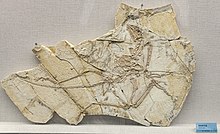Avialae
| Avialans | |
|---|---|

| |
| Fossil specimen of Jeholornis prima
| |

| |
| Collage of four extant birds. Clockwise from top-left: Spanish imperial eagle (Aquila adalberti), common ostrich (Struthio camelus), mallard (Anas platyrhynchos), and common kingfisher (Alcedo atthis) | |
| Scientific classification | |
| Domain: | Eukaryota |
| Kingdom: | Animalia |
| Phylum: | Chordata |
| Clade: | Dinosauria |
| Clade: | Saurischia |
| Clade: | Theropoda |
| Clade: | Pennaraptora |
| Clade: | Paraves |
| Clade: | Avialae Gauthier, 1986 |
| Subgroups | |
| |
Avialae ("bird wings") is a
Definition
Most researchers define Avialae as branch-based clade, though definitions vary. Many authors have used a definition similar to "all
Additionally, beginning in the late 2000s and early 2010s, several groups of researchers began adding the genus Troodon as an additional specifier in the definition of Avialae. Troodon had long been considered a close relative of the dromaeosaurids in the larger group Deinonychosauria, though some contemporary studies found it and other troodontids more closely related to modern birds, and so it has been specifically excluded from Avialae in more recent studies.[11]
Avialae is also occasionally defined as an apomorphy-based clade (that is, one based on derived characteristics that were not present among lineage predecessors). Jacques Gauthier, who named Avialae in 1986, re-defined it in 2001 as all dinosaurs that possessed feathered wings used in flapping flight, and the birds that descended from them.[12][13]
Differentiation from Aves
Gauthier and de Queiroz[13] (page 34) identified four conflicting ways of defining the term "Aves", which is a problem since the same biological name is being used four different ways. They proposed a solution, number 4 below, which is to reserve the term Aves only for the crown group, the last common ancestor of all living birds and all of its descendants. Other definitions of Aves found in literature were reassigned to other clade names.
- Aves can mean all reptiles closer to birds than to crocodiles (alternatively Avemetatarsalia [=Panaves])
- Aves can mean those advanced archosaurs with feathers (alternatively Avifilopluma)
- Aves can mean those feathered dinosaurs that can fly (alternately Avialae)
- Aves can mean the last common ancestor of all the currently living birds and all of its descendants (a "crown group"). (alternatively Neornithes)
Under the fourth definition Archaeopteryx is an avialan, and not a member of Aves. Gauthier's proposals have been adopted by many researchers in the field of paleontology and bird evolution, though the exact definitions applied have been inconsistent. Avialae, initially proposed to replace the traditional fossil content of Aves, is sometimes used synonymously with the vernacular term "bird" by these researchers.[11]
Evolution
| Cladogram following the results of a phylogenetic study by Wang et al., 2016.[14] |
The earliest known avialans come from the
Avialans diversified into a wide variety of forms during the
The following cladogram is based on the analysis by Hartman et al. (2019), which found flight likely evolved five separate times among paravian dinosaurs, two of those among Avialae (in Scansoriopterygids and other avialans). Archaeopteryx and "anchiornithids" were placed in Deinonychosauria, Avialae's sister group.[5]
In a study conducted in 2020, Archaeopteryx was recovered as an avialan.[20]
See also
References
- S2CID 140597349.
- .
- ^ S2CID 4471941.
- ^ PMID 31333906.
- S2CID 205218015.
- .
- ^ Weishampel, David B.; Dodson, Peter; Osmólska, Halszka (eds.) (2004). The Dinosauria, Second Edition. University of California Press., 861 pp.
- S2CID 83726237.
- S2CID 199493087.
- ^ S2CID 4364892.
- ^ Gauthier, J. (1986). "Saurischian monophyly and the origin of birds." In: K. Padian, ed. The origin of birds and the evolution of flight. San Francisco: California, Acad.Sci. pp.1–55. (Mem.Calif.Acad.Sci.8.)
- ^ a b Gauthier, J., and de Queiroz, K. (2001). "Feathered dinosaurs, flying dinosaurs, crown dinosaurs, and the name Aves." Pp. 7-41 in New perspectives on the origin and early evolution of birds: proceedings of the International Symposium in Honor of John H. Ostrom (J. A. Gauthier and L. F. Gall, eds.). Peabody Museum of Natural History, Yale University, New Haven, Connecticut, U.S.A.
- PMID 26806355.
- S2CID 206544531.
- PMID 34162868.
- PMID 31501339.
- ^ ISBN 978-0-86840-413-4.
- ^ Agency France-Presse (13 April 2011). "Birds survived dino extinction with keen senses". Cosmos Magazine. Archived from the original on 2 April 2015. Retrieved 11 June 2012.
- PMID 32140312.
